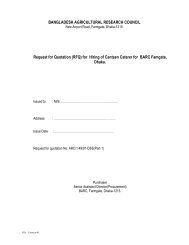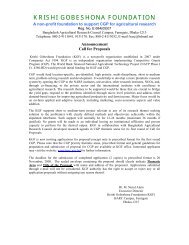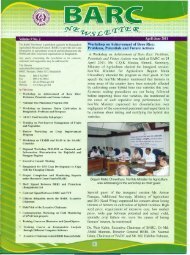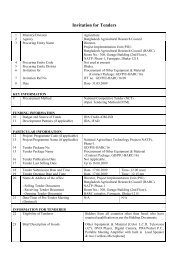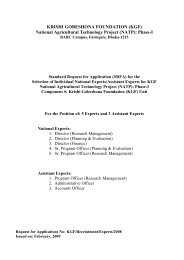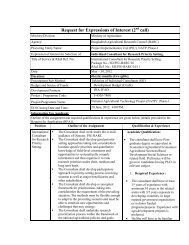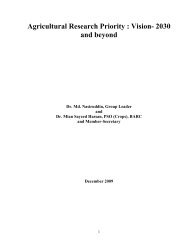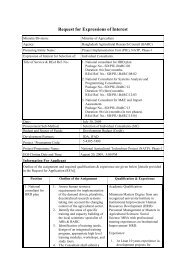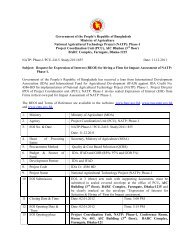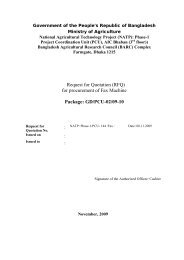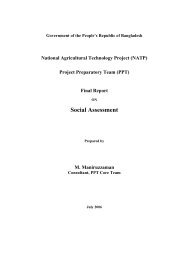ICT in Agriculture and Disaster Management - Bangladesh ...
ICT in Agriculture and Disaster Management - Bangladesh ...
ICT in Agriculture and Disaster Management - Bangladesh ...
Create successful ePaper yourself
Turn your PDF publications into a flip-book with our unique Google optimized e-Paper software.
was steady. Internet services are mostly available <strong>in</strong> metro city areas <strong>and</strong> at best the district<br />
head quarters. Only three connections were available per 1000 population <strong>in</strong> 2008, but <strong>in</strong> the<br />
base year, it was almost nil. As a consequence of this Public <strong>and</strong> Private sectors are<br />
develop<strong>in</strong>g service oriented application of <strong>ICT</strong> <strong>in</strong> agricultural development <strong>and</strong> technology<br />
dissem<strong>in</strong>ation.<br />
Current status of <strong>ICT</strong> <strong>in</strong> <strong>Bangladesh</strong> <strong>in</strong> respect of <strong>in</strong>frastructure <strong>and</strong> applications has made<br />
significant progress dur<strong>in</strong>g the last two decades. Review of various National policies <strong>and</strong><br />
other relevant documents showed that importance of <strong>ICT</strong> <strong>in</strong> agricultural research <strong>and</strong><br />
development has been recognized. Further, disaster management is the topmost priority of<br />
the Government. In perform<strong>in</strong>g the task, recommendations of the four regional workshops<br />
<strong>and</strong> the national workshop organized <strong>in</strong> this connection eleven other sub-sectoral report<br />
concern<strong>in</strong>g <strong>ICT</strong> <strong>and</strong> disaster management were consulted. Government’s policy towards<br />
development of <strong>in</strong>frastructure <strong>and</strong> enabl<strong>in</strong>g condition is highly positive.<br />
As <strong>ICT</strong> can play a significant role <strong>in</strong> research <strong>and</strong> development of agriculture <strong>and</strong> disaster<br />
management, the <strong>Bangladesh</strong> Agricultural Research Council appropriately has chosen the<br />
area as one of the sub-sectors for detailed study. This report is the outcome of the effort<br />
made by the <strong>Bangladesh</strong> Agricultural Research Council to conduct a sectoral study <strong>in</strong><br />
connection with the preparation of ‘Vision Document-2030 <strong>and</strong> beyond’. The ma<strong>in</strong> focus of<br />
this study is to elaborate how <strong>ICT</strong> can be applied <strong>in</strong> agriculture sector <strong>and</strong> its research <strong>and</strong><br />
development, technology dissem<strong>in</strong>ation, <strong>and</strong> disaster management. The methodology<br />
followed <strong>in</strong> prepar<strong>in</strong>g this report is a bit different from that followed <strong>in</strong> case of commodity<br />
based sub-sectors. However, the prescribed ToR <strong>and</strong> Group Work Guidel<strong>in</strong>es were followed<br />
wherever applicable or possible.<br />
Several National policies <strong>and</strong> other relevant documents were reviewed. Besides, many other<br />
secondary <strong>in</strong>formation were colleted from consultancy reports, <strong>in</strong>ternet resources <strong>and</strong> were<br />
reviewed. The most of the policies formulated after 2002 have stressed need for us<strong>in</strong>g <strong>ICT</strong>.<br />
Four Regional (Rajshahi, Chittagong, Barisal <strong>and</strong> Dhaka) Stakeholders Consultation<br />
Workshops on Agricultural Research Priority Sett<strong>in</strong>g were held dur<strong>in</strong>g December 2009 to<br />
February 2010. The number of participants varied from 100-170, but the proportionate mix<br />
was more or less the same. In all the Regional Workshops participants were drawn<br />
from/among Extension personnel from DAE, DOF <strong>and</strong> DLS (55%); Researchers from NARS<br />
<strong>and</strong> Universities (25%), NGOs, POs (<strong>in</strong>cluded private entrepreneurs, fertilizer dealers, etc),<br />
Others <strong>in</strong>cluded participants from BADC, BWDB, KGF, etc. (10%); Above all, to get the first<br />
h<strong>and</strong> <strong>in</strong>puts from the fields farmers (10%) participation was ensured. Breakout Groups<br />
varied with the context of the regional importance.<br />
Based on the <strong>in</strong>formation provided by <strong>and</strong> gathered from different agencies on researchable<br />
problems at various levels were analyzed for sett<strong>in</strong>g the priorities <strong>in</strong> the field of <strong>ICT</strong> <strong>in</strong><br />
agriculture <strong>and</strong> disaster management. The follow<strong>in</strong>g sources were considered:<br />
i. Research priorities of different ARIs<br />
ii. Outcomes of discussions with researchers form ARIs <strong>and</strong> Universities<br />
iii. Response from all extension agencies (DAE, DOF, DLS), who were requested to<br />
provide <strong>in</strong>formation on field problems<br />
iv. Researchable problems extracted from Upazila Micro Extension Plan<br />
v. Researchable issues on sub-sectoral commodities received from Hortex <strong>and</strong><br />
vi. Outcomes of four regional workshops which provided valuable <strong>in</strong>puts on<br />
regional issues<br />
x





